EDMA262: Mathematics Teaching 1 - Reflective Teaching Portfolio
VerifiedAdded on 2023/06/12
|8
|2042
|147
Portfolio
AI Summary
This document presents a student's reflective folio for a mathematics teaching portfolio, focusing on mathematical content knowledge, pedagogical content knowledge, and curriculum links. The portfolio includes entries discussing early number experiences, multiplication and division problems, invented algorithms, geometry, and measurement. It identifies connections to the Australian Curriculum and explores implications for future teaching practices, emphasizing the importance of reasoning, technology integration, and interdisciplinary approaches in mathematics education. Desklib offers similar solved assignments and past papers for students.
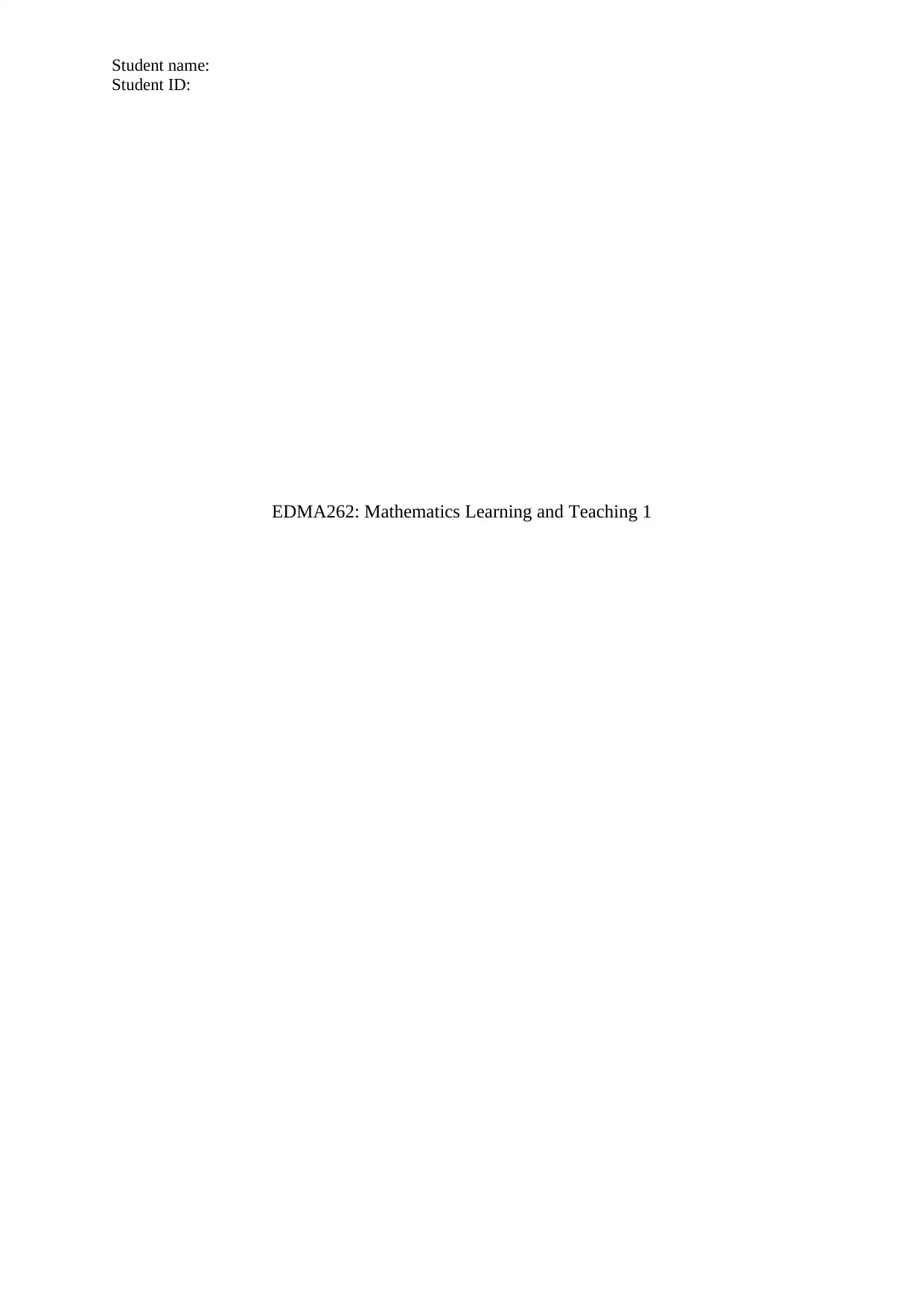
Student name:
Student ID:
EDMA262: Mathematics Learning and Teaching 1
Student ID:
EDMA262: Mathematics Learning and Teaching 1
Paraphrase This Document
Need a fresh take? Get an instant paraphrase of this document with our AI Paraphraser
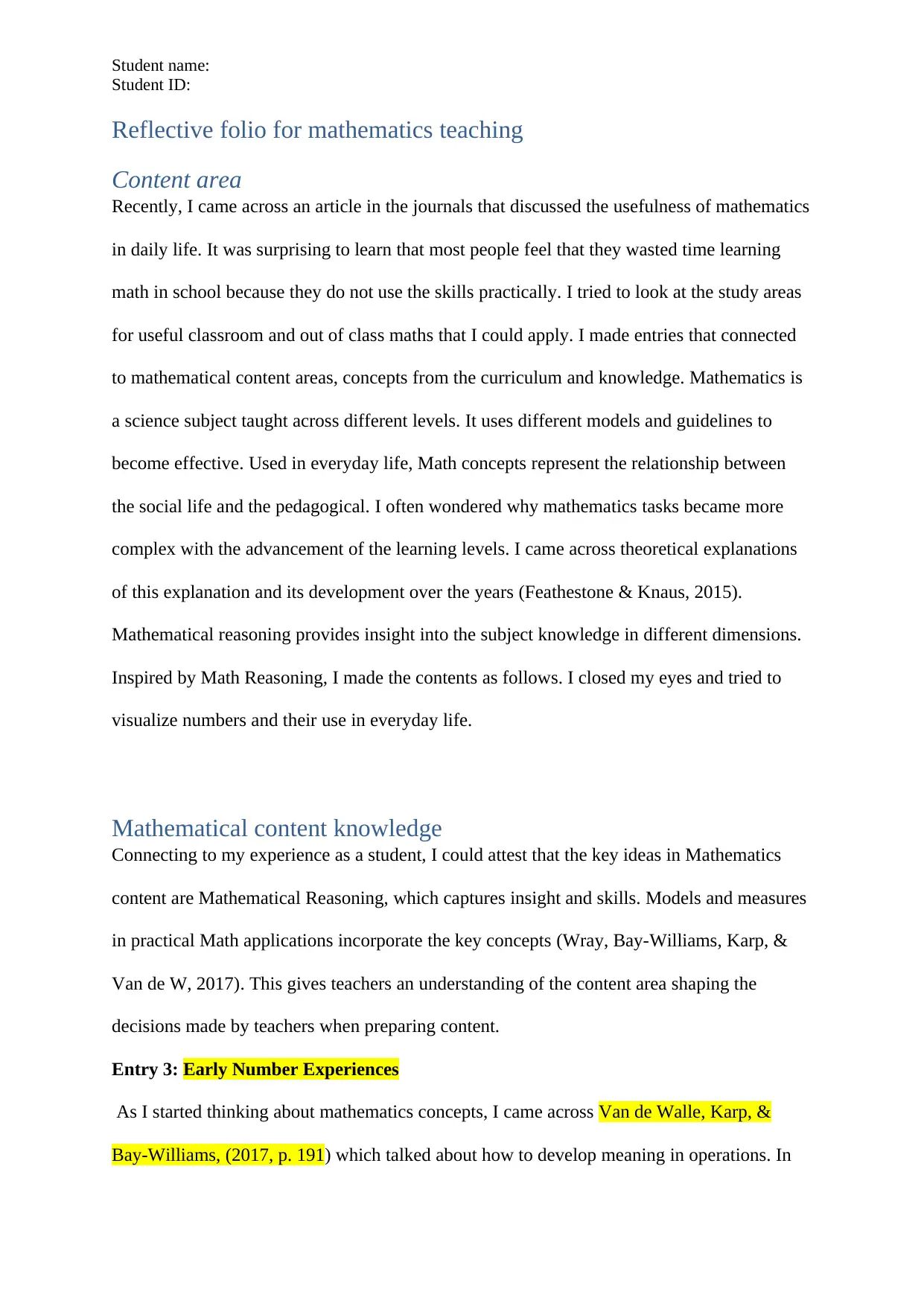
Student name:
Student ID:
Reflective folio for mathematics teaching
Content area
Recently, I came across an article in the journals that discussed the usefulness of mathematics
in daily life. It was surprising to learn that most people feel that they wasted time learning
math in school because they do not use the skills practically. I tried to look at the study areas
for useful classroom and out of class maths that I could apply. I made entries that connected
to mathematical content areas, concepts from the curriculum and knowledge. Mathematics is
a science subject taught across different levels. It uses different models and guidelines to
become effective. Used in everyday life, Math concepts represent the relationship between
the social life and the pedagogical. I often wondered why mathematics tasks became more
complex with the advancement of the learning levels. I came across theoretical explanations
of this explanation and its development over the years (Feathestone & Knaus, 2015).
Mathematical reasoning provides insight into the subject knowledge in different dimensions.
Inspired by Math Reasoning, I made the contents as follows. I closed my eyes and tried to
visualize numbers and their use in everyday life.
Mathematical content knowledge
Connecting to my experience as a student, I could attest that the key ideas in Mathematics
content are Mathematical Reasoning, which captures insight and skills. Models and measures
in practical Math applications incorporate the key concepts (Wray, Bay-Williams, Karp, &
Van de W, 2017). This gives teachers an understanding of the content area shaping the
decisions made by teachers when preparing content.
Entry 3: Early Number Experiences
As I started thinking about mathematics concepts, I came across Van de Walle, Karp, &
Bay-Williams, (2017, p. 191) which talked about how to develop meaning in operations. In
Student ID:
Reflective folio for mathematics teaching
Content area
Recently, I came across an article in the journals that discussed the usefulness of mathematics
in daily life. It was surprising to learn that most people feel that they wasted time learning
math in school because they do not use the skills practically. I tried to look at the study areas
for useful classroom and out of class maths that I could apply. I made entries that connected
to mathematical content areas, concepts from the curriculum and knowledge. Mathematics is
a science subject taught across different levels. It uses different models and guidelines to
become effective. Used in everyday life, Math concepts represent the relationship between
the social life and the pedagogical. I often wondered why mathematics tasks became more
complex with the advancement of the learning levels. I came across theoretical explanations
of this explanation and its development over the years (Feathestone & Knaus, 2015).
Mathematical reasoning provides insight into the subject knowledge in different dimensions.
Inspired by Math Reasoning, I made the contents as follows. I closed my eyes and tried to
visualize numbers and their use in everyday life.
Mathematical content knowledge
Connecting to my experience as a student, I could attest that the key ideas in Mathematics
content are Mathematical Reasoning, which captures insight and skills. Models and measures
in practical Math applications incorporate the key concepts (Wray, Bay-Williams, Karp, &
Van de W, 2017). This gives teachers an understanding of the content area shaping the
decisions made by teachers when preparing content.
Entry 3: Early Number Experiences
As I started thinking about mathematics concepts, I came across Van de Walle, Karp, &
Bay-Williams, (2017, p. 191) which talked about how to develop meaning in operations. In
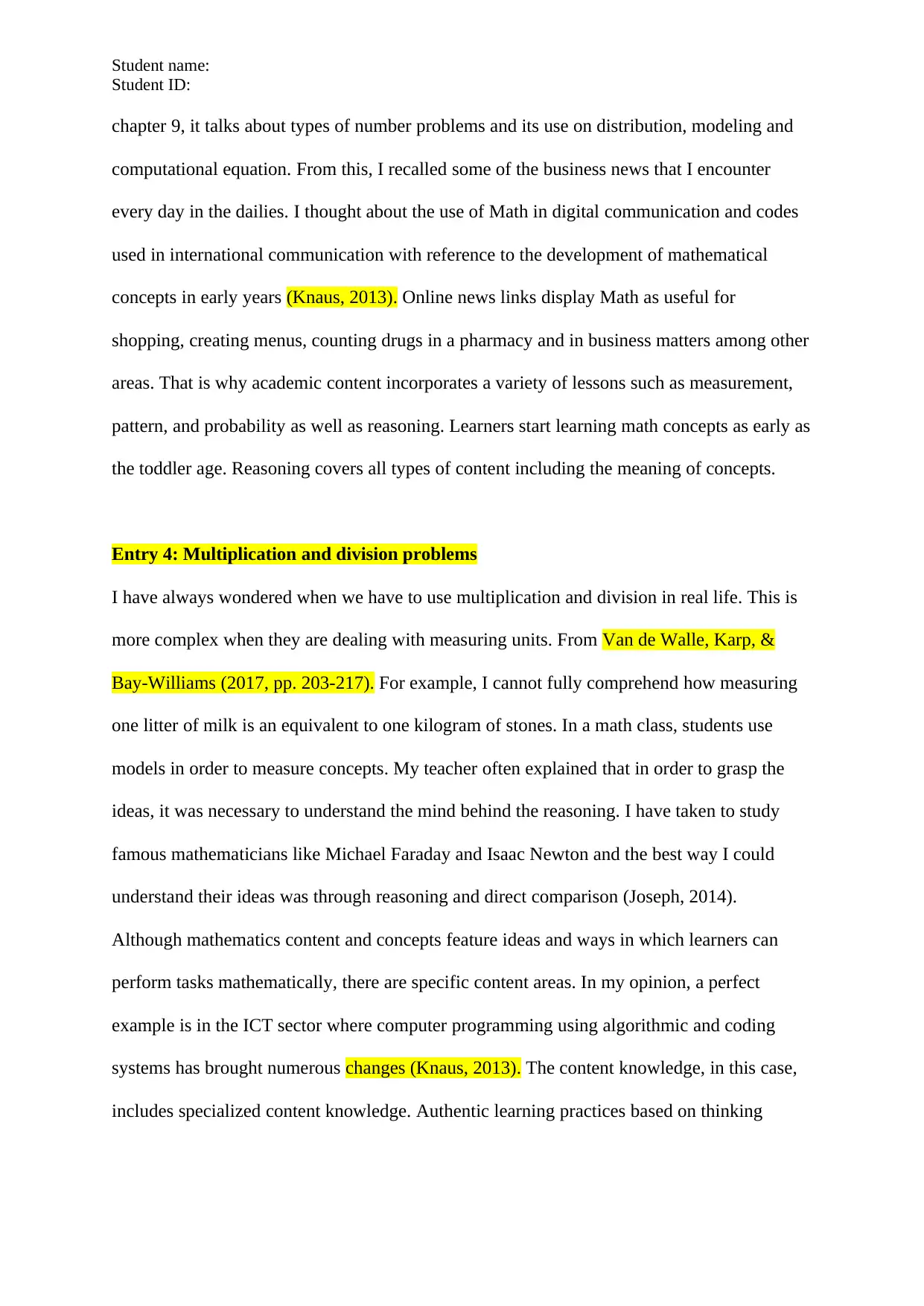
Student name:
Student ID:
chapter 9, it talks about types of number problems and its use on distribution, modeling and
computational equation. From this, I recalled some of the business news that I encounter
every day in the dailies. I thought about the use of Math in digital communication and codes
used in international communication with reference to the development of mathematical
concepts in early years (Knaus, 2013). Online news links display Math as useful for
shopping, creating menus, counting drugs in a pharmacy and in business matters among other
areas. That is why academic content incorporates a variety of lessons such as measurement,
pattern, and probability as well as reasoning. Learners start learning math concepts as early as
the toddler age. Reasoning covers all types of content including the meaning of concepts.
Entry 4: Multiplication and division problems
I have always wondered when we have to use multiplication and division in real life. This is
more complex when they are dealing with measuring units. From Van de Walle, Karp, &
Bay-Williams (2017, pp. 203-217). For example, I cannot fully comprehend how measuring
one litter of milk is an equivalent to one kilogram of stones. In a math class, students use
models in order to measure concepts. My teacher often explained that in order to grasp the
ideas, it was necessary to understand the mind behind the reasoning. I have taken to study
famous mathematicians like Michael Faraday and Isaac Newton and the best way I could
understand their ideas was through reasoning and direct comparison (Joseph, 2014).
Although mathematics content and concepts feature ideas and ways in which learners can
perform tasks mathematically, there are specific content areas. In my opinion, a perfect
example is in the ICT sector where computer programming using algorithmic and coding
systems has brought numerous changes (Knaus, 2013). The content knowledge, in this case,
includes specialized content knowledge. Authentic learning practices based on thinking
Student ID:
chapter 9, it talks about types of number problems and its use on distribution, modeling and
computational equation. From this, I recalled some of the business news that I encounter
every day in the dailies. I thought about the use of Math in digital communication and codes
used in international communication with reference to the development of mathematical
concepts in early years (Knaus, 2013). Online news links display Math as useful for
shopping, creating menus, counting drugs in a pharmacy and in business matters among other
areas. That is why academic content incorporates a variety of lessons such as measurement,
pattern, and probability as well as reasoning. Learners start learning math concepts as early as
the toddler age. Reasoning covers all types of content including the meaning of concepts.
Entry 4: Multiplication and division problems
I have always wondered when we have to use multiplication and division in real life. This is
more complex when they are dealing with measuring units. From Van de Walle, Karp, &
Bay-Williams (2017, pp. 203-217). For example, I cannot fully comprehend how measuring
one litter of milk is an equivalent to one kilogram of stones. In a math class, students use
models in order to measure concepts. My teacher often explained that in order to grasp the
ideas, it was necessary to understand the mind behind the reasoning. I have taken to study
famous mathematicians like Michael Faraday and Isaac Newton and the best way I could
understand their ideas was through reasoning and direct comparison (Joseph, 2014).
Although mathematics content and concepts feature ideas and ways in which learners can
perform tasks mathematically, there are specific content areas. In my opinion, a perfect
example is in the ICT sector where computer programming using algorithmic and coding
systems has brought numerous changes (Knaus, 2013). The content knowledge, in this case,
includes specialized content knowledge. Authentic learning practices based on thinking
⊘ This is a preview!⊘
Do you want full access?
Subscribe today to unlock all pages.

Trusted by 1+ million students worldwide
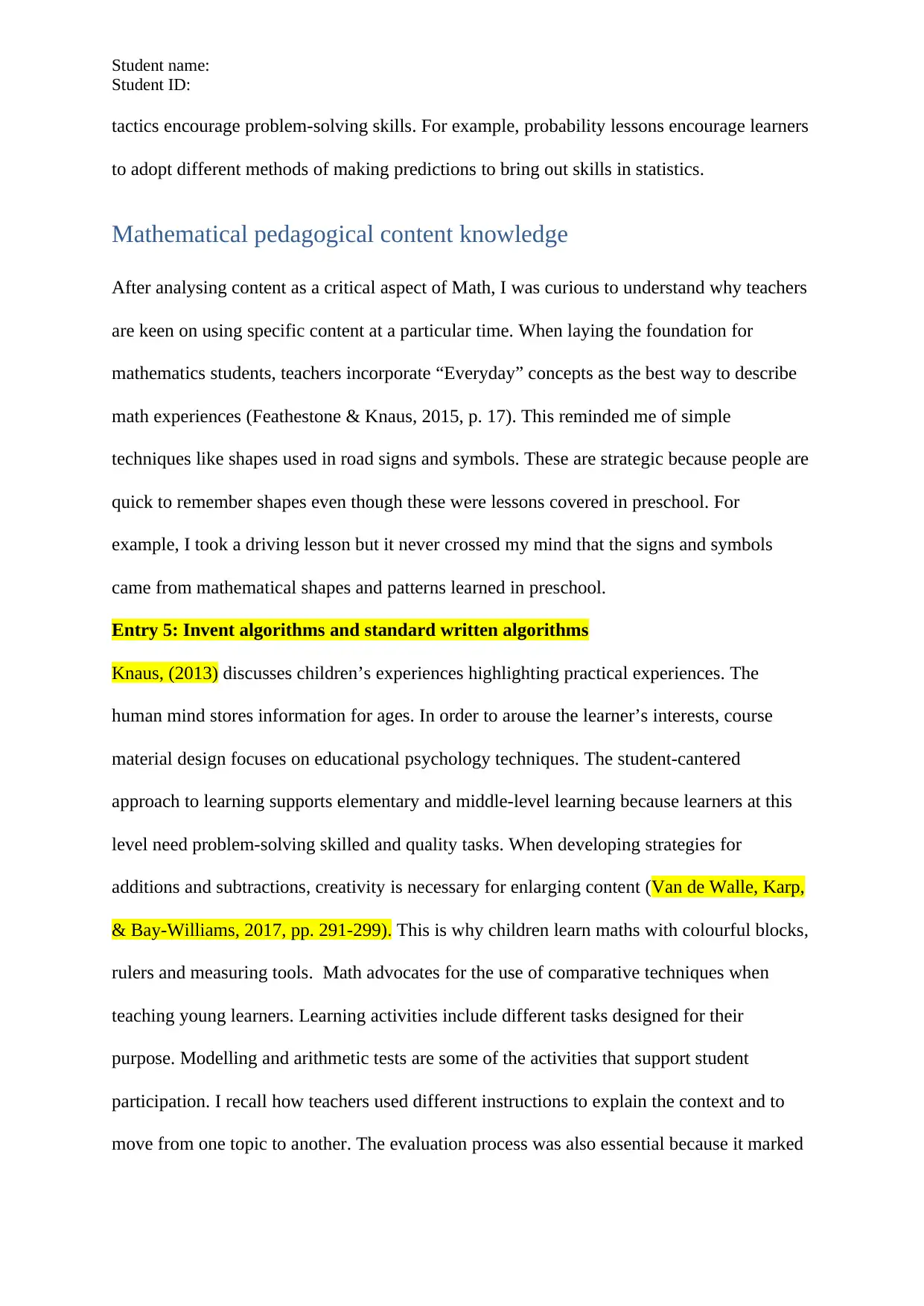
Student name:
Student ID:
tactics encourage problem-solving skills. For example, probability lessons encourage learners
to adopt different methods of making predictions to bring out skills in statistics.
Mathematical pedagogical content knowledge
After analysing content as a critical aspect of Math, I was curious to understand why teachers
are keen on using specific content at a particular time. When laying the foundation for
mathematics students, teachers incorporate “Everyday” concepts as the best way to describe
math experiences (Feathestone & Knaus, 2015, p. 17). This reminded me of simple
techniques like shapes used in road signs and symbols. These are strategic because people are
quick to remember shapes even though these were lessons covered in preschool. For
example, I took a driving lesson but it never crossed my mind that the signs and symbols
came from mathematical shapes and patterns learned in preschool.
Entry 5: Invent algorithms and standard written algorithms
Knaus, (2013) discusses children’s experiences highlighting practical experiences. The
human mind stores information for ages. In order to arouse the learner’s interests, course
material design focuses on educational psychology techniques. The student-cantered
approach to learning supports elementary and middle-level learning because learners at this
level need problem-solving skilled and quality tasks. When developing strategies for
additions and subtractions, creativity is necessary for enlarging content (Van de Walle, Karp,
& Bay-Williams, 2017, pp. 291-299). This is why children learn maths with colourful blocks,
rulers and measuring tools. Math advocates for the use of comparative techniques when
teaching young learners. Learning activities include different tasks designed for their
purpose. Modelling and arithmetic tests are some of the activities that support student
participation. I recall how teachers used different instructions to explain the context and to
move from one topic to another. The evaluation process was also essential because it marked
Student ID:
tactics encourage problem-solving skills. For example, probability lessons encourage learners
to adopt different methods of making predictions to bring out skills in statistics.
Mathematical pedagogical content knowledge
After analysing content as a critical aspect of Math, I was curious to understand why teachers
are keen on using specific content at a particular time. When laying the foundation for
mathematics students, teachers incorporate “Everyday” concepts as the best way to describe
math experiences (Feathestone & Knaus, 2015, p. 17). This reminded me of simple
techniques like shapes used in road signs and symbols. These are strategic because people are
quick to remember shapes even though these were lessons covered in preschool. For
example, I took a driving lesson but it never crossed my mind that the signs and symbols
came from mathematical shapes and patterns learned in preschool.
Entry 5: Invent algorithms and standard written algorithms
Knaus, (2013) discusses children’s experiences highlighting practical experiences. The
human mind stores information for ages. In order to arouse the learner’s interests, course
material design focuses on educational psychology techniques. The student-cantered
approach to learning supports elementary and middle-level learning because learners at this
level need problem-solving skilled and quality tasks. When developing strategies for
additions and subtractions, creativity is necessary for enlarging content (Van de Walle, Karp,
& Bay-Williams, 2017, pp. 291-299). This is why children learn maths with colourful blocks,
rulers and measuring tools. Math advocates for the use of comparative techniques when
teaching young learners. Learning activities include different tasks designed for their
purpose. Modelling and arithmetic tests are some of the activities that support student
participation. I recall how teachers used different instructions to explain the context and to
move from one topic to another. The evaluation process was also essential because it marked
Paraphrase This Document
Need a fresh take? Get an instant paraphrase of this document with our AI Paraphraser
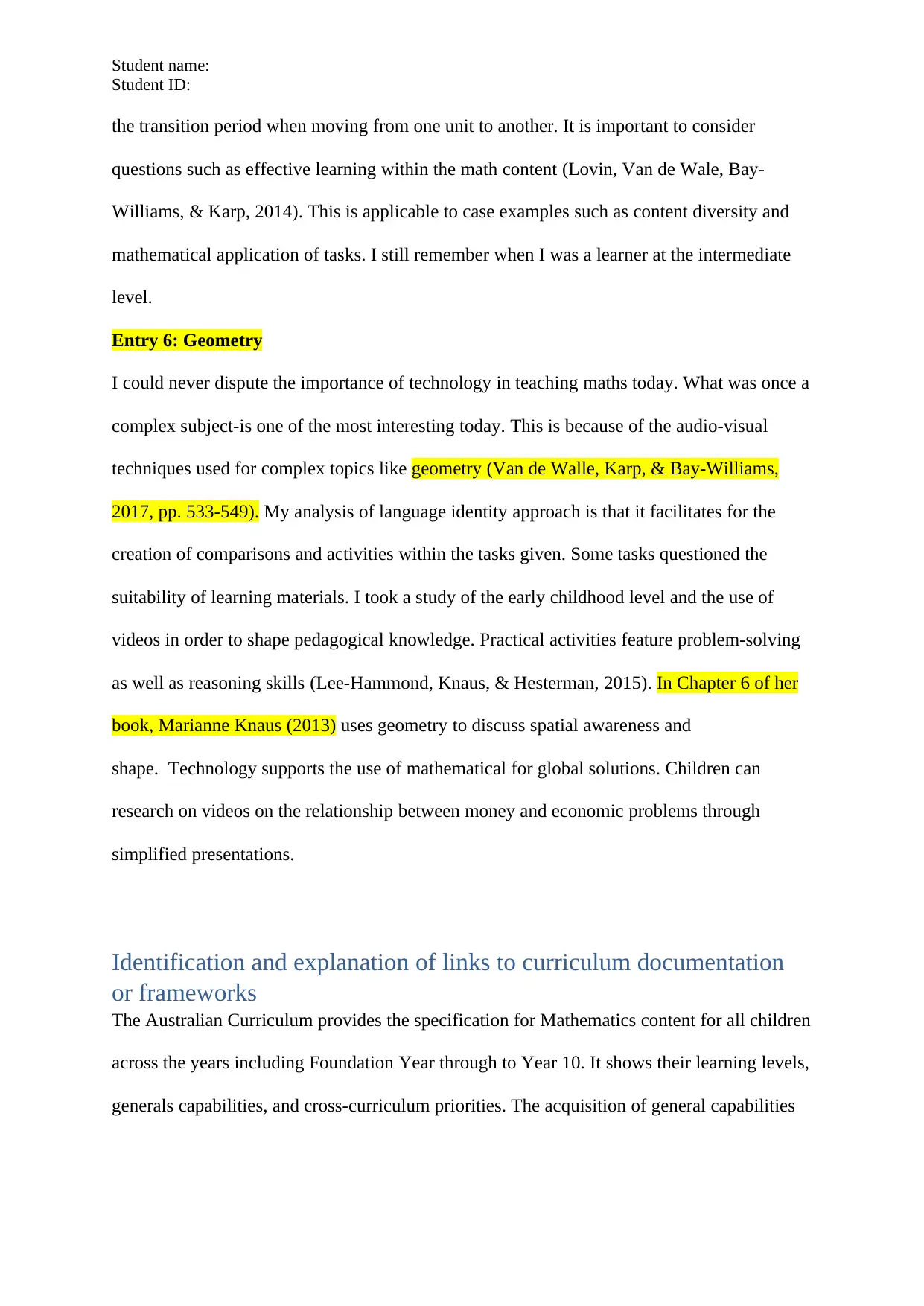
Student name:
Student ID:
the transition period when moving from one unit to another. It is important to consider
questions such as effective learning within the math content (Lovin, Van de Wale, Bay-
Williams, & Karp, 2014). This is applicable to case examples such as content diversity and
mathematical application of tasks. I still remember when I was a learner at the intermediate
level.
Entry 6: Geometry
I could never dispute the importance of technology in teaching maths today. What was once a
complex subject-is one of the most interesting today. This is because of the audio-visual
techniques used for complex topics like geometry (Van de Walle, Karp, & Bay-Williams,
2017, pp. 533-549). My analysis of language identity approach is that it facilitates for the
creation of comparisons and activities within the tasks given. Some tasks questioned the
suitability of learning materials. I took a study of the early childhood level and the use of
videos in order to shape pedagogical knowledge. Practical activities feature problem-solving
as well as reasoning skills (Lee-Hammond, Knaus, & Hesterman, 2015). In Chapter 6 of her
book, Marianne Knaus (2013) uses geometry to discuss spatial awareness and
shape. Technology supports the use of mathematical for global solutions. Children can
research on videos on the relationship between money and economic problems through
simplified presentations.
Identification and explanation of links to curriculum documentation
or frameworks
The Australian Curriculum provides the specification for Mathematics content for all children
across the years including Foundation Year through to Year 10. It shows their learning levels,
generals capabilities, and cross-curriculum priorities. The acquisition of general capabilities
Student ID:
the transition period when moving from one unit to another. It is important to consider
questions such as effective learning within the math content (Lovin, Van de Wale, Bay-
Williams, & Karp, 2014). This is applicable to case examples such as content diversity and
mathematical application of tasks. I still remember when I was a learner at the intermediate
level.
Entry 6: Geometry
I could never dispute the importance of technology in teaching maths today. What was once a
complex subject-is one of the most interesting today. This is because of the audio-visual
techniques used for complex topics like geometry (Van de Walle, Karp, & Bay-Williams,
2017, pp. 533-549). My analysis of language identity approach is that it facilitates for the
creation of comparisons and activities within the tasks given. Some tasks questioned the
suitability of learning materials. I took a study of the early childhood level and the use of
videos in order to shape pedagogical knowledge. Practical activities feature problem-solving
as well as reasoning skills (Lee-Hammond, Knaus, & Hesterman, 2015). In Chapter 6 of her
book, Marianne Knaus (2013) uses geometry to discuss spatial awareness and
shape. Technology supports the use of mathematical for global solutions. Children can
research on videos on the relationship between money and economic problems through
simplified presentations.
Identification and explanation of links to curriculum documentation
or frameworks
The Australian Curriculum provides the specification for Mathematics content for all children
across the years including Foundation Year through to Year 10. It shows their learning levels,
generals capabilities, and cross-curriculum priorities. The acquisition of general capabilities
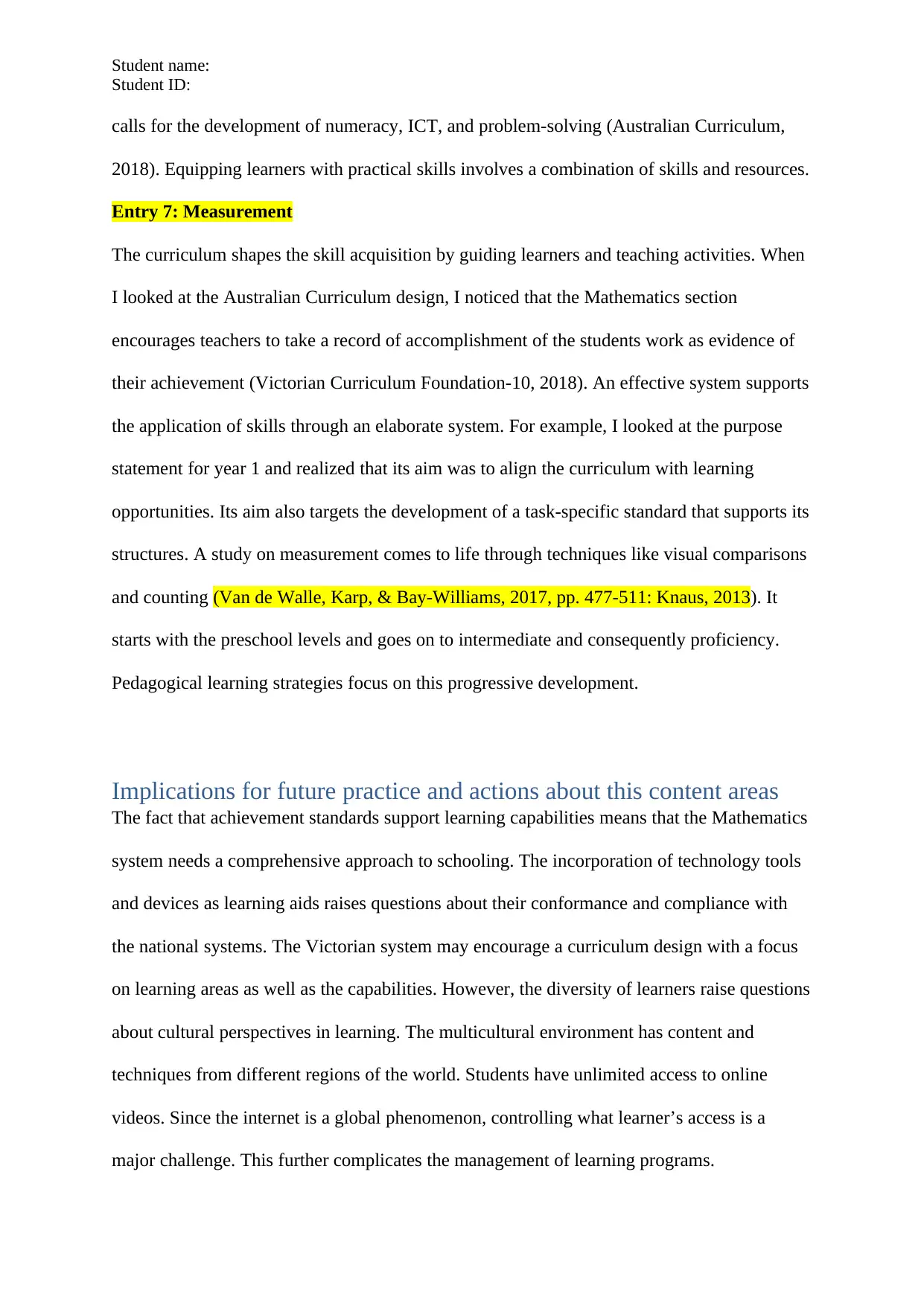
Student name:
Student ID:
calls for the development of numeracy, ICT, and problem-solving (Australian Curriculum,
2018). Equipping learners with practical skills involves a combination of skills and resources.
Entry 7: Measurement
The curriculum shapes the skill acquisition by guiding learners and teaching activities. When
I looked at the Australian Curriculum design, I noticed that the Mathematics section
encourages teachers to take a record of accomplishment of the students work as evidence of
their achievement (Victorian Curriculum Foundation-10, 2018). An effective system supports
the application of skills through an elaborate system. For example, I looked at the purpose
statement for year 1 and realized that its aim was to align the curriculum with learning
opportunities. Its aim also targets the development of a task-specific standard that supports its
structures. A study on measurement comes to life through techniques like visual comparisons
and counting (Van de Walle, Karp, & Bay-Williams, 2017, pp. 477-511: Knaus, 2013). It
starts with the preschool levels and goes on to intermediate and consequently proficiency.
Pedagogical learning strategies focus on this progressive development.
Implications for future practice and actions about this content areas
The fact that achievement standards support learning capabilities means that the Mathematics
system needs a comprehensive approach to schooling. The incorporation of technology tools
and devices as learning aids raises questions about their conformance and compliance with
the national systems. The Victorian system may encourage a curriculum design with a focus
on learning areas as well as the capabilities. However, the diversity of learners raise questions
about cultural perspectives in learning. The multicultural environment has content and
techniques from different regions of the world. Students have unlimited access to online
videos. Since the internet is a global phenomenon, controlling what learner’s access is a
major challenge. This further complicates the management of learning programs.
Student ID:
calls for the development of numeracy, ICT, and problem-solving (Australian Curriculum,
2018). Equipping learners with practical skills involves a combination of skills and resources.
Entry 7: Measurement
The curriculum shapes the skill acquisition by guiding learners and teaching activities. When
I looked at the Australian Curriculum design, I noticed that the Mathematics section
encourages teachers to take a record of accomplishment of the students work as evidence of
their achievement (Victorian Curriculum Foundation-10, 2018). An effective system supports
the application of skills through an elaborate system. For example, I looked at the purpose
statement for year 1 and realized that its aim was to align the curriculum with learning
opportunities. Its aim also targets the development of a task-specific standard that supports its
structures. A study on measurement comes to life through techniques like visual comparisons
and counting (Van de Walle, Karp, & Bay-Williams, 2017, pp. 477-511: Knaus, 2013). It
starts with the preschool levels and goes on to intermediate and consequently proficiency.
Pedagogical learning strategies focus on this progressive development.
Implications for future practice and actions about this content areas
The fact that achievement standards support learning capabilities means that the Mathematics
system needs a comprehensive approach to schooling. The incorporation of technology tools
and devices as learning aids raises questions about their conformance and compliance with
the national systems. The Victorian system may encourage a curriculum design with a focus
on learning areas as well as the capabilities. However, the diversity of learners raise questions
about cultural perspectives in learning. The multicultural environment has content and
techniques from different regions of the world. Students have unlimited access to online
videos. Since the internet is a global phenomenon, controlling what learner’s access is a
major challenge. This further complicates the management of learning programs.
⊘ This is a preview!⊘
Do you want full access?
Subscribe today to unlock all pages.

Trusted by 1+ million students worldwide
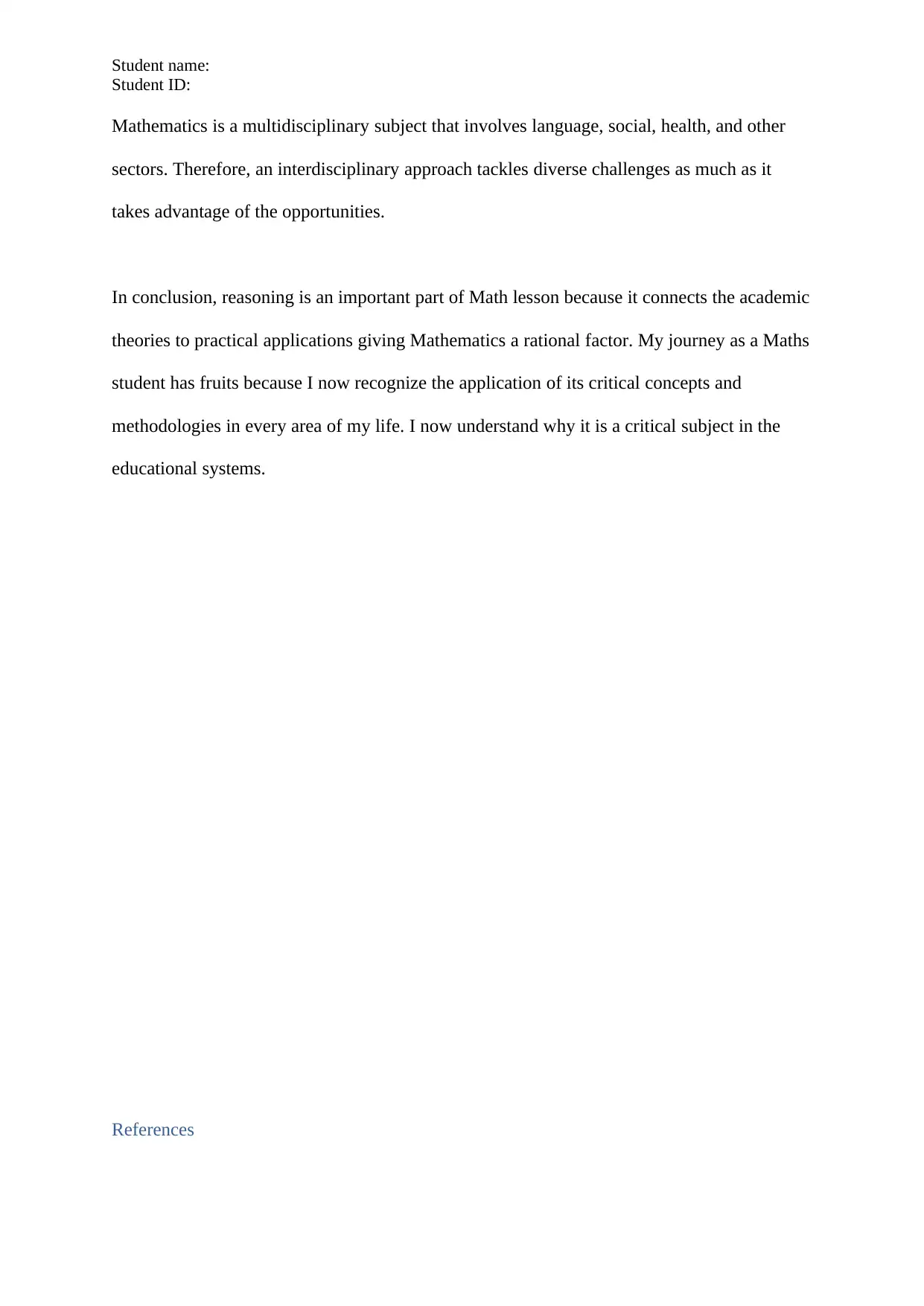
Student name:
Student ID:
Mathematics is a multidisciplinary subject that involves language, social, health, and other
sectors. Therefore, an interdisciplinary approach tackles diverse challenges as much as it
takes advantage of the opportunities.
In conclusion, reasoning is an important part of Math lesson because it connects the academic
theories to practical applications giving Mathematics a rational factor. My journey as a Maths
student has fruits because I now recognize the application of its critical concepts and
methodologies in every area of my life. I now understand why it is a critical subject in the
educational systems.
References
Student ID:
Mathematics is a multidisciplinary subject that involves language, social, health, and other
sectors. Therefore, an interdisciplinary approach tackles diverse challenges as much as it
takes advantage of the opportunities.
In conclusion, reasoning is an important part of Math lesson because it connects the academic
theories to practical applications giving Mathematics a rational factor. My journey as a Maths
student has fruits because I now recognize the application of its critical concepts and
methodologies in every area of my life. I now understand why it is a critical subject in the
educational systems.
References
Paraphrase This Document
Need a fresh take? Get an instant paraphrase of this document with our AI Paraphraser
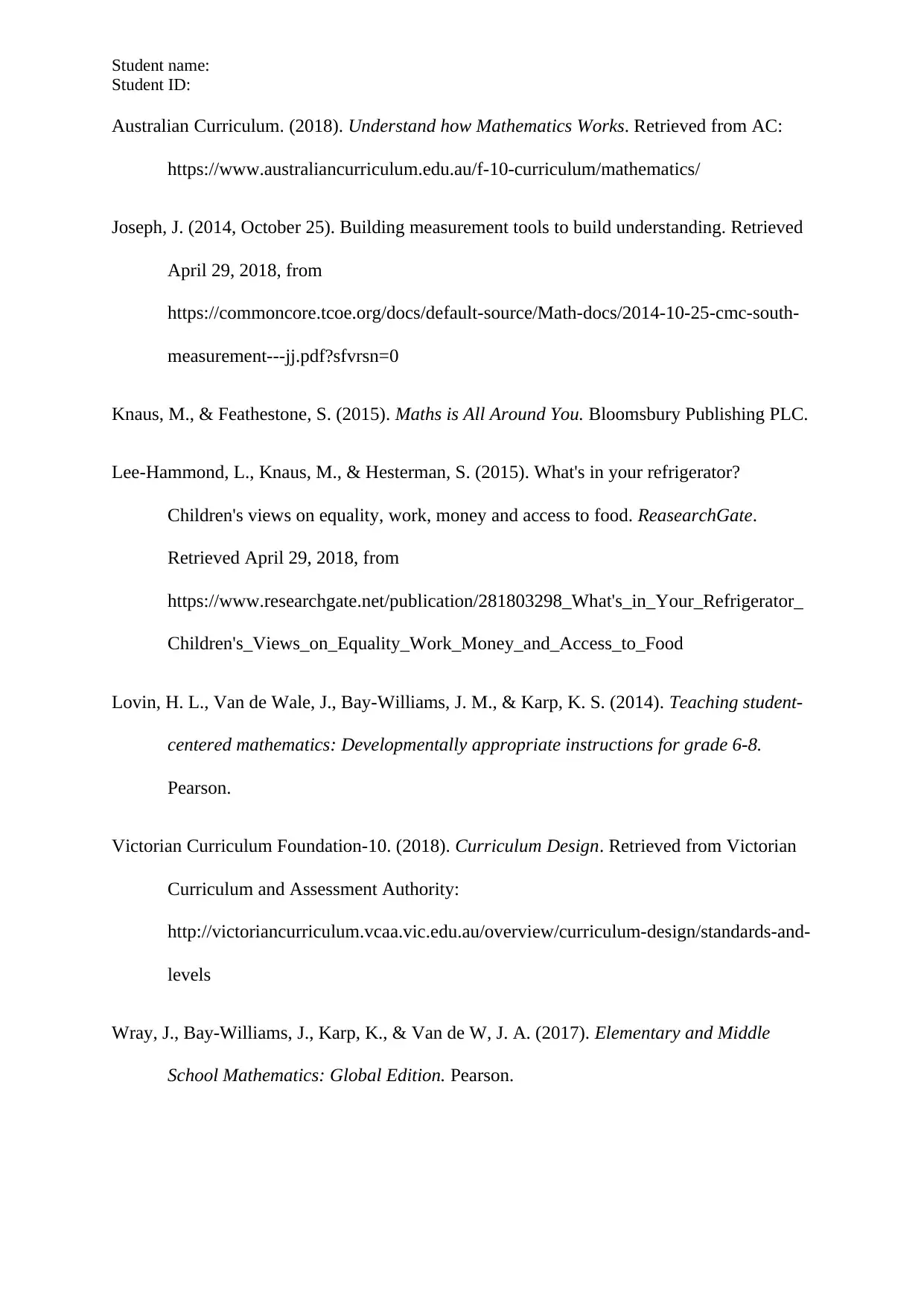
Student name:
Student ID:
Australian Curriculum. (2018). Understand how Mathematics Works. Retrieved from AC:
https://www.australiancurriculum.edu.au/f-10-curriculum/mathematics/
Joseph, J. (2014, October 25). Building measurement tools to build understanding. Retrieved
April 29, 2018, from
https://commoncore.tcoe.org/docs/default-source/Math-docs/2014-10-25-cmc-south-
measurement---jj.pdf?sfvrsn=0
Knaus, M., & Feathestone, S. (2015). Maths is All Around You. Bloomsbury Publishing PLC.
Lee-Hammond, L., Knaus, M., & Hesterman, S. (2015). What's in your refrigerator?
Children's views on equality, work, money and access to food. ReasearchGate.
Retrieved April 29, 2018, from
https://www.researchgate.net/publication/281803298_What's_in_Your_Refrigerator_
Children's_Views_on_Equality_Work_Money_and_Access_to_Food
Lovin, H. L., Van de Wale, J., Bay-Williams, J. M., & Karp, K. S. (2014). Teaching student-
centered mathematics: Developmentally appropriate instructions for grade 6-8.
Pearson.
Victorian Curriculum Foundation-10. (2018). Curriculum Design. Retrieved from Victorian
Curriculum and Assessment Authority:
http://victoriancurriculum.vcaa.vic.edu.au/overview/curriculum-design/standards-and-
levels
Wray, J., Bay-Williams, J., Karp, K., & Van de W, J. A. (2017). Elementary and Middle
School Mathematics: Global Edition. Pearson.
Student ID:
Australian Curriculum. (2018). Understand how Mathematics Works. Retrieved from AC:
https://www.australiancurriculum.edu.au/f-10-curriculum/mathematics/
Joseph, J. (2014, October 25). Building measurement tools to build understanding. Retrieved
April 29, 2018, from
https://commoncore.tcoe.org/docs/default-source/Math-docs/2014-10-25-cmc-south-
measurement---jj.pdf?sfvrsn=0
Knaus, M., & Feathestone, S. (2015). Maths is All Around You. Bloomsbury Publishing PLC.
Lee-Hammond, L., Knaus, M., & Hesterman, S. (2015). What's in your refrigerator?
Children's views on equality, work, money and access to food. ReasearchGate.
Retrieved April 29, 2018, from
https://www.researchgate.net/publication/281803298_What's_in_Your_Refrigerator_
Children's_Views_on_Equality_Work_Money_and_Access_to_Food
Lovin, H. L., Van de Wale, J., Bay-Williams, J. M., & Karp, K. S. (2014). Teaching student-
centered mathematics: Developmentally appropriate instructions for grade 6-8.
Pearson.
Victorian Curriculum Foundation-10. (2018). Curriculum Design. Retrieved from Victorian
Curriculum and Assessment Authority:
http://victoriancurriculum.vcaa.vic.edu.au/overview/curriculum-design/standards-and-
levels
Wray, J., Bay-Williams, J., Karp, K., & Van de W, J. A. (2017). Elementary and Middle
School Mathematics: Global Edition. Pearson.
1 out of 8
Your All-in-One AI-Powered Toolkit for Academic Success.
+13062052269
info@desklib.com
Available 24*7 on WhatsApp / Email
![[object Object]](/_next/static/media/star-bottom.7253800d.svg)
Unlock your academic potential
Copyright © 2020–2025 A2Z Services. All Rights Reserved. Developed and managed by ZUCOL.